
DETROIT (AP) — Investigators in the U.S. and Canada are looking into a crash in the Canadian province of Newfoundland in which a woman was killed by an exploding air bag inflator made by ARC Automotive Inc. of Knoxville, Tennessee.
As many as 8 million ARC inflators are under scrutiny in the U.S., mainly in older cars, although it hasn't been determined how many of those are defective. Although the results are similar, the ARC problem is different from one that resulted in the recall of 69 million inflators in the U.S. made by Takata Corp.
Authorities say the Canadian woman was killed July 8 when the ARC inflator ruptured and sent metal shrapnel into the passenger compartment of 2009 Hyundai Elantra she was driving. Without the shrapnel injuries, the driver likely would have survived the low-speed crash, Canadian officials said. Now, investigators from both countries are trying to figure out what caused the inflator to blow apart.
The death raises more questions about the safety of air bags, which rely on explosions to fill bags that protect people in crashes. It also brought new urgency to a probe opened last year by the U.S. National Highway Traffic Safety Administration after an Ohio woman was injured by an ARC inflator. The U.S. safety agency on Thursday upgraded its investigation to an engineering analysis, a step closer to a recall.
Messages were left seeking comment from ARC. NHTSA's Canadian counterpart, Transport Canada, said ARC is cooperating.
NHTSA said it is focusing on determining the entire population of ARC inflators in the U.S., which it estimates at 8 million mainly in older vehicles made by General Motors, Fiat Chrysler, Hyundai and Kia.
"Should a safety defect be found, owners will be notified," Transport Canada said in a statement.
U.S. investigators began looking at ARC inflators in July of last year after getting reports that the Ohio woman was seriously hurt when her 2002 Chrysler Town & Country minivan crashed and the inflator ruptured. The agency said it also found another injury involving someone in a 2004 Kia Optima midsize car. In both cases, the inflators were made at ARC's factory in Knoxville, according to agency documents.
In the probe, NHTSA focused on inflators made from 2000 until September of 2004. The population includes about 2.6 million that were sold to General Motors.
According to NHTSA, the Elantra in the Newfoundland crash had an ARC inflator that was made in China, but it's unknown whether any of the same inflators were used in other U.S. vehicles. ARC has confirmed that the Canadian Elantra inflator "was substantially the same design" as the one used in at least one other U.S. model, the 2004 Optima, the agency said.
Hyundai said the 2009 Elantra in the U.S. has a two-stage air bag inflator, not a single-stage one like the Canadian version. The automaker said it's cooperating with investigators.
NHTSA said in a statement that it would direct the collection and testing of ARC inflators as it tries to determine what caused them to rupture. The agency said it will focus on determining how many ARC inflators are in the U.S. and whether any made in China were sold here.
Takata inflators have been blamed for at least 11 and as many as 14 deaths worldwide, as well as hundreds of injuries. Takata uses the explosive chemical ammonium nitrate to inflate air bags, but the chemical can degrade over time and burn too quickly, blowing apart metal inflator canisters.
ARC uses a small amount of ammonium nitrate to ignite another chemical that inflates air bags, and authorities say they are not looking at ammonium nitrate as the cause. Instead, they are focusing on whether a manufacturing problem can block a vent in the ARC inflators. With no place for the gas to escape, a metal inflator canister can be blown into pieces.
Documents show that the Chrysler incident with an ARC inflator happened Jan. 29, 2009, in Ashtabula, Ohio. A man complained in writing to NHTSA that his wife was hurt by shrapnel when the air bag deployed after their minivan collided with a snowmobile. "Most of the shrapnel went into her chest, with the air bag plate breaking apart, striking her in the chin, breaking her jaw in three places," wrote the man, who was not identified. An ambulance crew saved her from bleeding to death, he wrote.
NHTSA still believes that air bags save lives and do more good than harm. Mark Rosekind, the agency's administrator, told an auto industry conference near Traverse City, Michigan, on Wednesday that air bags top a list of new technologies responsible for saving 613,501 lives.
____
Rob Gillies in Toronto and Dee-Ann Durbin in Detroit contributed to this report.






















